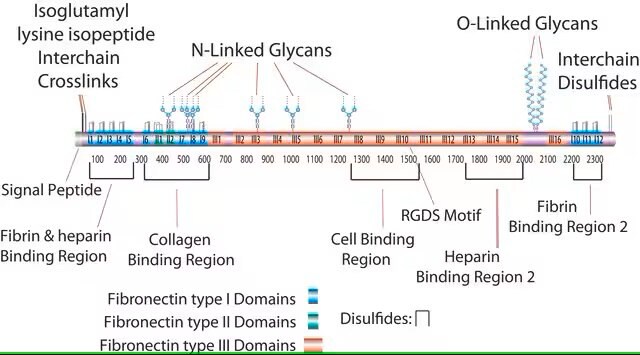The concentration of this product is 1 mg/mL. This information is reported in the product Certificate of Analysis. Please see the link below to review a sample or lot-specific Certificate:
https://www.sigmaaldrich.com/product/sigma/f1141#product-documentation
F1141
Bovine Fibronectin
from bovine plasma, liquid, suitable for cell culture
Sinonimo/i:
Fibronectina
Scegli un formato
Scegli un formato
About This Item
Prodotti consigliati
Nome del prodotto
Fibronectina plasma bovino, solution, sterile-filtered, BioReagent, suitable for cell culture
Origine biologica
bovine plasma
Livello qualitativo
Sterilità
sterile-filtered
Nome Commerciale
BioReagent
Stato
solution
Confezionamento
pkg of 1 mg
pkg of 2 mg
pkg of 5 mg
tecniche
cell culture | mammalian: suitable
Copertura della superficie
1‑5 μg/cm2
N° accesso UniProt
Specificità del legame
Peptide Source: Collagen
Peptide Source: Fibrinogen
Condizioni di spedizione
wet ice
Temperatura di conservazione
2-8°C
Informazioni sul gene
bovine ... FN1(280794)
Cerchi prodotti simili? Visita Guida al confronto tra prodotti
Descrizione generale
Applicazioni
Azioni biochim/fisiol
Risultati analitici
Altre note
Raccomandato
Avvertenze
Danger
Indicazioni di pericolo
Consigli di prudenza
Classi di pericolo
Resp. Sens. 1 - Skin Sens. 1
Codice della classe di stoccaggio
12 - Non Combustible Liquids
Classe di pericolosità dell'acqua (WGK)
WGK 3
Punto d’infiammabilità (°F)
Not applicable
Punto d’infiammabilità (°C)
Not applicable
Dispositivi di protezione individuale
Eyeshields, Gloves
Scegli una delle versioni più recenti:
Certificati d'analisi (COA)
Non trovi la versione di tuo interesse?
Se hai bisogno di una versione specifica, puoi cercare il certificato tramite il numero di lotto.
Possiedi già questo prodotto?
I documenti relativi ai prodotti acquistati recentemente sono disponibili nell’Archivio dei documenti.
I clienti hanno visto anche
Articoli
Fibronectin (FN) plays crucial roles in extracellular matrix fibril assembly and cellular interactions.
The extracellular matrix (ECM) and its attachment factor components are discussed in this article in relation to their function in structural biology and their availability for in vitro applications.
The extracellular matrix (ECM) is secreted by cells and surrounds them in tissues.
3D cell culture overview. Learn about 2D vs 3D cell culture, advantages of 3D cell culture, and techniques available to develop 3D cell models
Protocolli
Dilute fibronectin for cell attachment, varying per cell type. Coating protocol, products, and FAQs provided.
Contenuto correlato
Cell culture media expertise accelerates lab-grown meat and seafood industry with animal-free formulations.
-
Hi, I bought a vial with 5mg of Fibronectin (F1141), but so far, I have not been able to find the concentration of this solution. Can you please help me with this info? Thanks a lot in advance!
1 answer-
Helpful?
-
-
What is the procedure for coating culture surfaces with fibronectin?
1 answer-
To coat culture surfaces: 1. Dilute fibronectin in sterile balanced salt solution and coat the culture surface (1-5 μg/cm2) with a minimal volume. 2. Allow to air dry for at least 45 minutes at room temperature. Excess fibronectin may be removed by aspiration, but this is not necessary.
Helpful?
-
-
How long can I store the fibronectin solution?
1 answer-
The product is good for at least a year at 2-8 °C if kept sterile.
Helpful?
-
-
How do I choose which fibronectin product to use to coat culture surfaces for cell growth?
1 answer-
The species source for the fibronectin used when coating culture surfaces is not important. It is the presence of the RGD binding site that is present in all fibronectins that promotes binding.
Helpful?
-
-
How long can I store fibronectin coated plates, etc?
1 answer-
Fibronectin coated cultureware can be stored for 2-4 weeks at 2-8 °C in a closed sterile container, or in sterile sealable bags.
Helpful?
-
-
What is the Department of Transportation shipping information for this product?
1 answer-
Transportation information can be found in Section 14 of the product's (M)SDS.To access the shipping information for this material, use the link on the product detail page for the product.
Helpful?
-
Active Filters
Il team dei nostri ricercatori vanta grande esperienza in tutte le aree della ricerca quali Life Science, scienza dei materiali, sintesi chimica, cromatografia, discipline analitiche, ecc..
Contatta l'Assistenza Tecnica.











